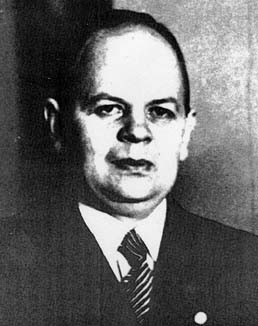Wilhelm Ackermann facts for kids
Quick facts for kids
Wilhelm Ackermann
|
|
|---|---|

Wilhelm Ackermann in c. 1935
|
|
| Born | 29 March 1896 Herscheid, German Empire
|
| Died | 24 December 1962 (aged 66) Lüdenscheid, West Germany
|
| Nationality | German |
| Alma mater | University of Göttingen |
| Known for |
|
| Scientific career | |
| Fields | Mathematics |
| Doctoral advisor | David Hilbert |
Wilhelm Friedrich Ackermann (born March 29, 1896 – died December 24, 1962) was a German mathematician and logician. He is famous for his work in mathematical logic, which is a field that uses math to study how we reason and solve problems. He is especially known for something called the Ackermann function. This function is a key example in the theory of computation, which is about how computers and calculations work.
Contents
Wilhelm Ackermann's Early Life and Education
Wilhelm Ackermann was born in Herscheid, a town in Germany. He was a very bright student. He went to the University of Göttingen, which is a well-known university in Germany. In 1925, he earned his Ph.D. (a high-level university degree). His main study was about proving that mathematical systems are consistent, meaning they don't lead to contradictions. This work was important in a field called proof theory, which looks at how mathematical proofs are built.
Teaching Career and Academic Work
After finishing his studies, Ackermann became a teacher. From 1929 to 1948, he taught at a school called Arnoldinum Gymnasium in Steinfurt. Later, he taught in Lüdenscheid until 1961. Even though he was a high school teacher, he also kept up with his research. He was a member of the Academy of Sciences in Göttingen and an honorary professor at the University of Münster. This shows he was highly respected in the world of mathematics.
Key Contributions to Logic and Mathematics
Wilhelm Ackermann made several important contributions to mathematics and logic.
Working with David Hilbert
In 1928, Ackermann worked with a very famous mathematician named David Hilbert. They turned Hilbert's lectures on mathematical logic into a book called Principles of Mathematical Logic. This book was groundbreaking because it was the first time that first-order logic was clearly explained. First-order logic is a way to represent and analyze arguments using symbols. The book also brought up important questions about whether these logical systems were complete or could be decided by a computer.
Developing Consistency Proofs
Ackermann continued to work on proving the "consistency" of different mathematical systems. Consistency means that a system does not contain any contradictions. If a system is consistent, it means you can't prove both a statement and its opposite within that system. He created consistency proofs for:
- Set theory in 1937 (Set theory is about collections of objects).
- Full arithmetic in 1940 (Arithmetic is the study of numbers and operations like addition and subtraction).
- Type-free logic in 1952.
- A new way to set up axiomatic set theory in 1956.
The Famous Ackermann Function
One of his most famous contributions is the Ackermann function. This function is special because it grows incredibly fast. It's used in computer science to understand how complex some calculations can be. It's a great example to show how some functions can be computed, but they take a huge amount of steps or memory.
Later Life and Legacy
Wilhelm Ackermann continued to teach and do research throughout his life. He published many articles about the basic ideas of mathematics. He passed away in Lüdenscheid, Germany, in December 1962. His work helped shape the fields of mathematical logic and the theory of computation, and his ideas are still studied today.
See also
 In Spanish: Wilhelm Ackermann para niños
In Spanish: Wilhelm Ackermann para niños
- Ackermann coding
- Ackermann function
- Ackermann set theory
- Hilbert–Ackermann system
- Entscheidungsproblem
- Inverse Ackermann function

